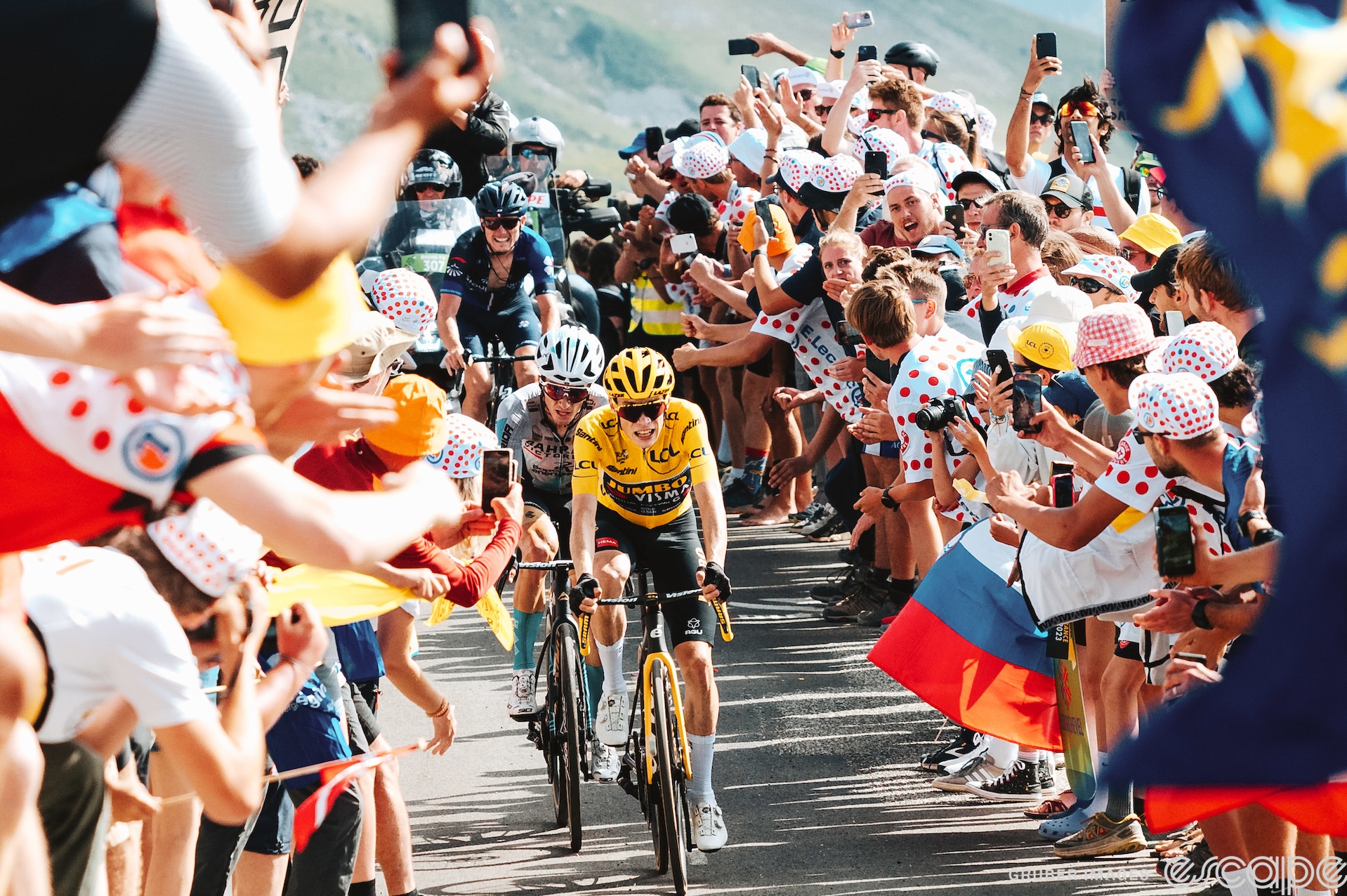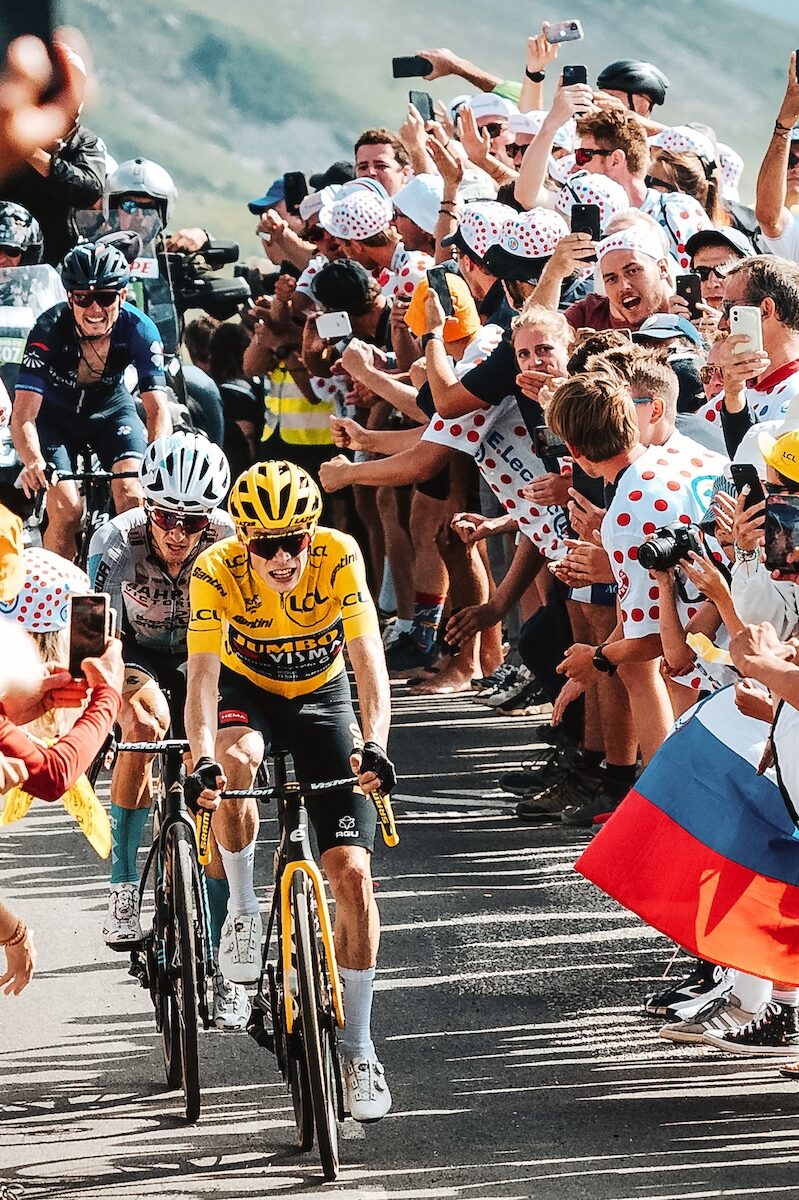It’s hard to say which crash was worse.
In late March at the mid-week Dwars door Vlaanderen, the group of favorites was bunched tightly together while jostling for position on the notorious, high-speed descent off the Kanarieberg when a touch of wheels brought down a dozen riders. Among them: Classics stars like Wout van Aert, who broke a collarbone, several ribs, and his sternum, and Mads Pedersen.
Just days later at Itzulia Basque Country, another mass crash on a descent took down some of the top stage racers in the sport, some smacking heavily into a stone storm culvert or cyclocrossing into the woods after narrowly avoiding several motorcycle-sized boulders. The race was neutralized as Primož Roglič, Remco Evenepoel, Jonas Vingegaard and eight others all DNF’d. Vingegaard was in hospital for almost two weeks with major chest injuries including a pneumothorax.
It’s also hard to overstate the impact of the two crashes on the 2024 season, even as the full effect has yet to play out. Instead of a hotly anticipated cobbles matchup between superstar rivals Van Aert and Mathieu van der Poel with Pedersen as spoiler, Van der Poel laid long-range attacks to romp to wins at Flanders and again at Roubaix. Van Aert’s planned Giro d’Italia campaign was also scuttled, robbing that race of one of its most interesting storylines. Finally, it was just over a week before the Tour de France that we finally learned Vingegaard will take the start, although the two-time defending champion’s form is an open question.
The 2024 WorldTour is clearly worse off for the absence of some of its best riders and biggest stars at its most important races. And it’s worth wondering what, if anything, might have led to a different outcome. It’s not an abstract barstool debate. One longtime team manager thinks that a sport where riders, teams, and most race organizers didn’t have to fight so hard just to exist – one that allowed the relative luxury of prioritizing the collective good on matters like safety – might do just that.
“Cycling in its current form suffers from a kind of short-term thinking, because that’s the way the sport has always operated economically,” EF Education-EasyPost general manager Jonathan Vaughters told Escape Collective. “That mentality exists with riders, it exists with teams, it exists with races.
“Safety is a cost. And if [a promoter] is thinking about, ‘How do I get this sponsor maximum publicity this year, because I need to re-sign them for next year,’ you’re going to design the most spectacular race route you can, and make the televised product as spectacular as possible. Safety, unfortunately, is not going to hit that list.” To Vaughters, the only way to finally fix that is to reform the sport.
Reform, of course, has been a hot topic in men’s pro cycling the past many months. Last fall, just after the failed merger between Jumbo-Visma and Soudal-Quick Step, news agency Reuters dropped a bombshell: top teams in the sport, led by Jumbo manager Richard Plugge, were exploring a major reform initiative that would re-shape men’s professional road racing. (Two sources for this story said that women’s racing has not been a focus of discussions.)
Later dubbed One Cycling, the new league would be a mix of existing and new races, backed by at least five WorldTeams and outside investors. In early February, Reuters reported that the deep pockets – to the tune of a €250 million investment – belonged to none other than Saudi Arabia’s sovereign Public Investment Fund, which has actively invested in other global sports like golf and tennis. The fund, acting through a division called SRJ Sports Investment, planned to finalize the commercial aspects of the deal “over the next two months,” according to Reuters. After several false starts, serious reform finally seemed to be coming to pro cycling.
Instead, things quickly began to go pear-shaped. First, Tour de France director Christian Prudhomme said in February that the project “doesn’t interest me,” and any rejection from the Amaury Sports Organization, the company that runs the biggest bike race in the world, was certainly inauspicious for One Cycling’s ability to remake the sport.
The ASO declined an interview request for this article, saying it does not comment on the topic. It also declined to say if Prudhomme’s comments in February still represented its position. In an interview in Ride magazine’s Tour de France special issue published in June, Prudhomme noted the singular importance of the Tour’s French identity. “I sometimes say: the French government is our boss,” he said. And although no reports have said the Tour was for sale – to any buyer, foreign or domestic – Prudhomme added that he doesn’t think the Tour would ever end up in foreign ownership, which suggests the ASO will pick even its partners very carefully.
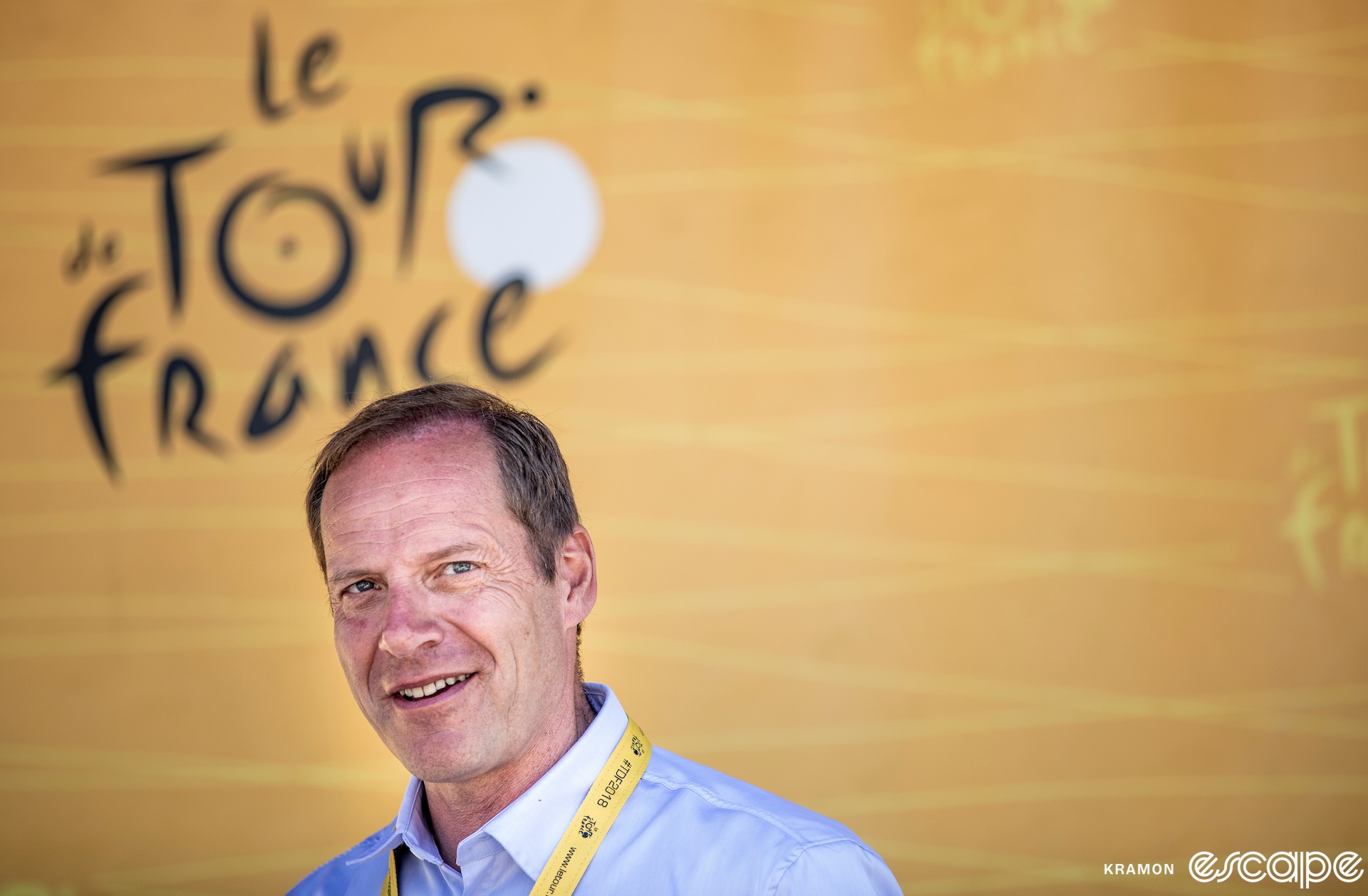
Signs of discord arose elsewhere too. In late February, L’Equipe reported that a number of WorldTeams were backing out of the project due to what were said to be unrealistic return-on-investment demands by SRJ and what one unnamed team manager called “a crazy business model, if there is even one.”
Brent Copeland, general manager of Jayco-AlUla and new head of the pro teams’ association, the AIGCP, told Escape Collective in late March that he spoke with One Cycling representatives “but didn’t carry on discussions with them.” He declined to comment on specifics, citing a non-disclosure agreement, but did say he thought that to enact any significant reforms, “the most important thing is to get all stakeholders and teams as united as possible. And the feeling I got from this was there was a big division between stakeholders.” That Copeland’s team doesn’t appear to be on board with a project supposedly backed by the Saudi sovereign wealth fund seems significant, given that the team’s co-sponsor is the Saudi state tourism board for AlUla, a UNESCO World Heritage site that has become one of the Kingdom’s key tourism destinations.
Since the froth of speculation in February, talk of One Cycling has died down considerably and the supposed two-month timeline to finalize the deal has now stretched to more than twice that with no news, leading to speculation the project is off. Although SRJ did not respond to an e-mailed request for comment, sources with knowledge of the discussions say that One Cycling is in fact still very much alive. And reform in the sport may even begin to happen – in some form if not as One Cycling from the start – as soon as the 2026 season. “To make reform [in the sport] is no secret,” said Plugge in a brief interview at the Tour of Flanders. “The goal is to make it sustainable for the future.”
But as One Cycling’s ups and downs and the failures of past reform initiatives show, nothing is guaranteed. And if One Cycling is to succeed, it will have to do so by aligning a fractious group of pro teams, race organizers, and the sport’s governing body to work together in a way they never have, in service of a highly speculative pitch that everyone would like to believe but no one knows is true: that cycling is a vastly undervalued sport that could be supercharged into a global powerhouse, if only those in it have the will to see the transformation through.
The long and winding road to reform
Pro cycling’s current form is an ad hoc creation: an accretion of events that pre-date the sport’s governing body by decades, populated by a group of stakeholders with wildly disparate power, and littered with experiments with different approaches (like national teams) and attempts at reform, of which One Cycling is assuredly just the latest.
Modern reform efforts date back some 20 years. Hein Verbruggen’s tenure as UCI president is best known for coinciding with the rise of the sport’s EPO era, in particular accusations that under his leadership the governing body hid or ignored evidence of doping at Lance Armstrong’s United States Postal Service team. (Verbruggen denied this until he passed away in 2017, but both the United States Anti-Doping Agency’s investigation into USPS and the Cycling Independent Reform Commission found Armstrong benefitted from preferential treatment by Verbruggen and the UCI in several instances.)
But Verbruggen was unquestionably a modernizing force in the sport. When he assumed the role of president in 1984, the organization, then called the Federation Internationale du Cyclisme Professionel (FICP), was a sleepy backwater with a handful of employees, a modest budget of several million dollars, and no real relationship with the powerful International Olympic Committee.
Verbruggen engineered the reunification of the FICP and amateur FIAC, moved the fused organization’s headquarters to Lausanne, close to the heart of the Olympic movement (and later to nearby Aigle), and brokered the entry of professional racers into the Games themselves, in 1996, along with the first Olympic mountain bike race.
Under Verbruggen, the UCI opened a worldwide performance center and velodrome at its Aigle HQ; created the mountain bike, cyclocross, and track World Cups; and grew the organization into a major international governing body that now employs dozens and operates on an annual budget of around CHF 40 million (US$45 million).
His most enduring impact on road racing, however, might be the WorldTour, which got its start as a 2004 UCI reform proposal called the ProTour: a unified calendar that offered guaranteed invites for top teams to the biggest races, ending the old patronage system where race organizers had complete control over invites.
The ProTour was always controversial and met with fierce resistance from organizers like the ASO. The turf war came to a head that was by turns dramatic and comical in the 2007 and 2008 seasons, after Verbruggen left the UCI to chair the IOC’s Beijing Olympics efforts. In 2007, the Astana team saw three positive tests, including from team captain (and now general manager) Alexandre Vinokourov at that year’s Tour. Incensed, the next spring the ASO barred the team from all of its races, including the Tour, in contravention of UCI ProTour rules even though Astana’s management had changed in the offseason (ironically to former Postal manager Johan Bruyneel). While the ASO held firm on its ban except for the Critérium du Dauphiné, Verbruggen’s vision ultimately won out, and largely became what is today’s WorldTour.
More recent fans of the sport, in turn, will likely remember the failed Velon Hammer Series, an initiative from a number of WorldTeams that attempted to introduce new stage races with a novel, team-based format over a series of three annual events starting in 2017, with media rights (and revenues) pooled and shared amongst stakeholders. Amid opposition from race organizers (including the ASO) and the UCI, the Hammer Series folded abruptly midway through its third season.
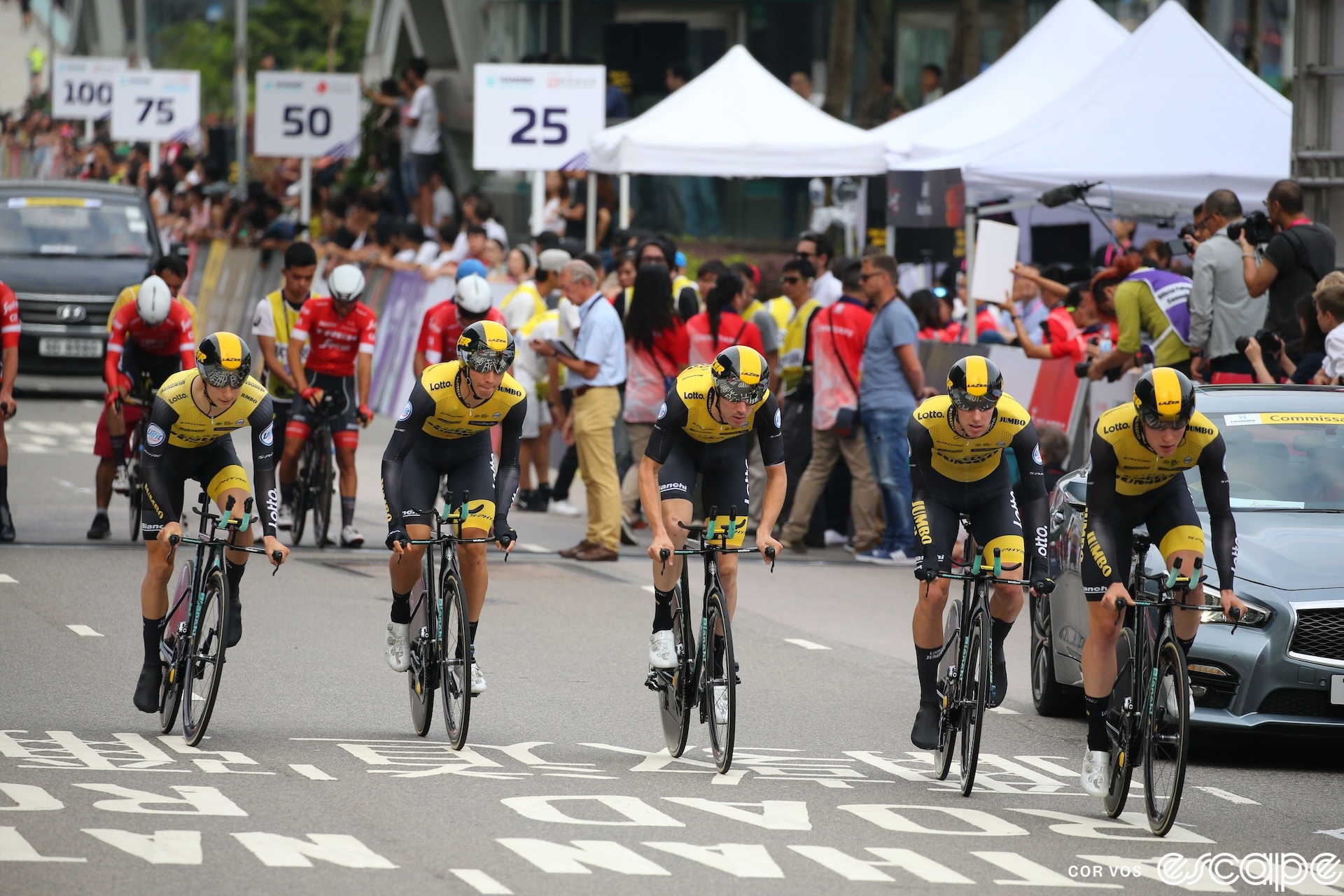
Because One Cycling required NDAs from potential partners, some sources for this story, like Copeland, declined to comment on it specifically. Others like Vaughters would speak only in general about reform and current issues in the sport. And some sources spoke on condition of anonymity. Much of what One Cycling plans is either undecided or cloaked in secrecy. But it’s clear that the project is philosophically an evolution of the old Hammer Series. The contours: a calendar with a mix of existing and new events – including possibly new formats – with pooled media rights and revenue sharing are broadly the same. And it faces many of the same structural challenges that doomed its predecessor.
On the other side of the equation, One Cycling also has more going for it, in two key ways.
First is the money. Two sources confirmed to Escape that the €250 million investment figure cited by Reuters is accurate. That’s over as long as a 10-year commitment, although spending would be heaviest in the first few years. Still, that is an order of magnitude more backing than Velon ever had for the Hammer Series, which means One Cycling could start with a much larger slate of events and a longer runway to succeed.
Second is how the players are aligned this time around. In its February story, Reuters reported that Big 4 accounting firm EY (formerly Ernst & Young) was a key participant in One Cycling and had shopped the opportunity to potential investors, with SRJ’s bid beating out one from private equity firm CVC Capital. EY is, of course, the longtime audit partner for the UCI.
The UCI declined an interview request for president David Lappartient, citing his busy pre-Tour and Olympics schedule. “The UCI currently does not have all the necessary information regarding the OneCycling [sic] project and is therefore not in a position to take a stance on it at this time,” the organization’s press office said in an emailed response. It added, “The UCI supports initiatives that seek to improve professional cycling, but these must be done under the leadership of the UCI, in collaboration with all cycling stakeholders, in order to jointly develop and improve our sport.”
That statement can be read several ways, but is far more receptive than the UCI ever was to the Hammer Series. “We’re on a good path,” said Plugge of the UCI’s attitude to current reform efforts. “David Lappartient wants to leave the sport in a better place in a couple of years.”
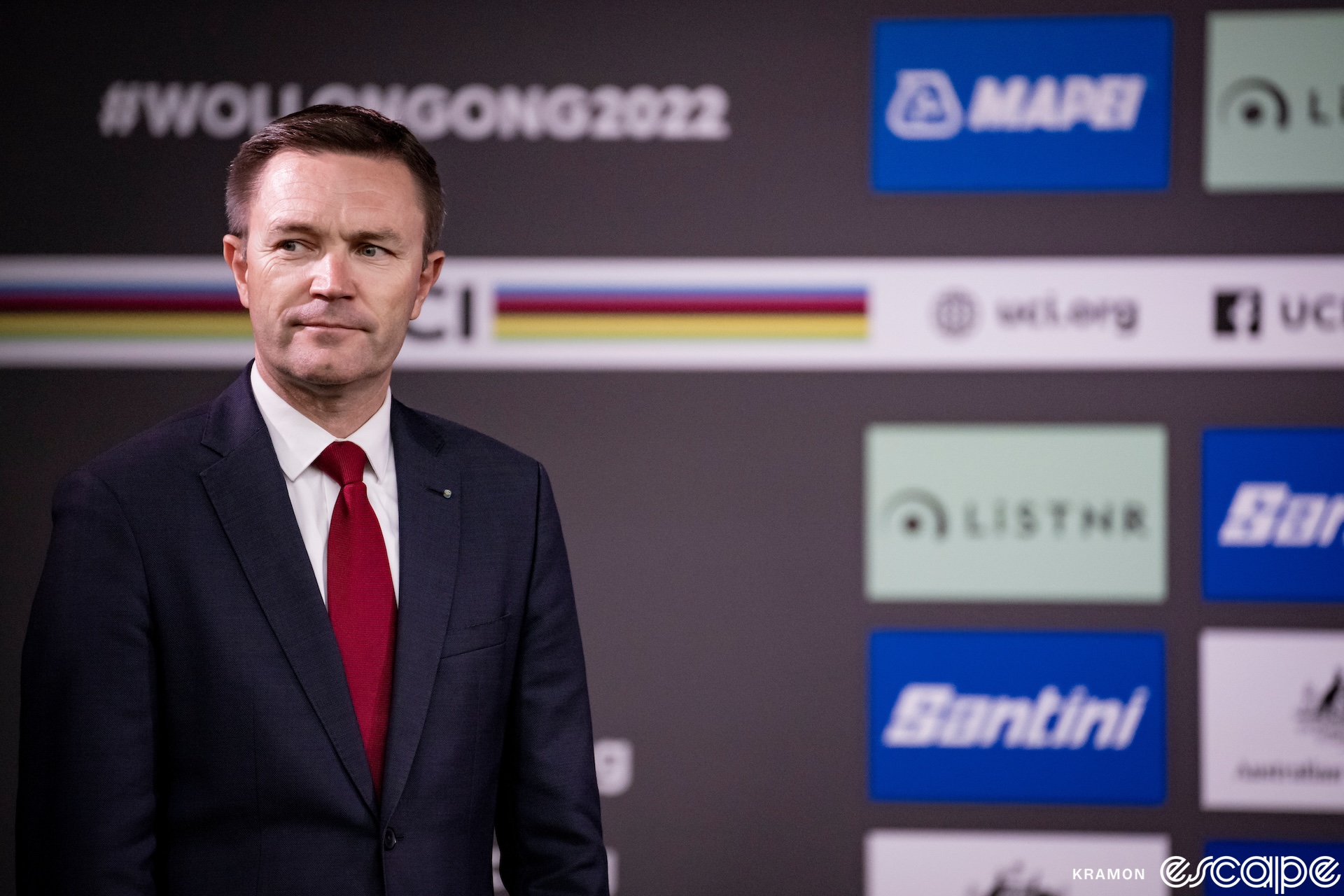
All of that sounds auspicious. The overcrowded WorldTour calendar would be reformed into a cohesive unit and, presumably, a more attractive one to broadcasters. “The biggest elephant in the room is TV rights,” said Jayco’s Copeland. “If there was a way of making that more appetizing for the broadcasters, (we could) get them to sell more TV rights, bring in more revenue, and split it between the teams.” As with Velon, the broad solution from One Cycling is to take those rights, currently owned by individual race organizers, and pool them into a single package presumably worth more than they are piecemeal.
New race formats and a reformed calendar with a coherent championship-style narrative arc could draw in casual fans, growing audiences and, subsequently, the value of future media rights. And those new revenues, in turn, would be shared among stakeholders, creating more value and stability, enabling the sport to grow further.
But even with those key obstacles seemingly solved, success is far from assured. I asked some sources what sports they saw as models for reform, and heard answers ranging from Formula 1 to the National Football League to the English Premier League. I also heard answers like tennis.
Those are all good answers. It makes sense to point to properties like the EPL or NFL, which are some of the richest sports leagues in the world. And tennis, or golf – both of which are in the midst of philosophical and financial battles over their futures, with Saudi money playing a role – seem like decent analogues as well, although one similarity between all three – marquee men’s and women’s circuits – again points out the glaring absence of women’s racing from the One Cycling discussion.
But they’re at best imperfect comparisons, and the reason why is simple: pro road racing doesn’t work like any of those sports. “You can’t use a model that comes from, say, football,” said Israel-Premier Tech owner Sylvan Adams, speaking last February to Escape contributor Andy McGrath. “The sport isn’t financed like football.”
The Coelacanth of sports
Pro road racing is, in a word, weird.
It’s at once an individual and a team sport. First person across the line wins, but only in one-day races; for stage races the winner has the lowest elapsed time across all stages combined, even if they don’t win a single stage. That doesn’t really roll off the tongue. Races can be as short as one day or as long as three weeks. The one-day events can be pan-flat or have thousands of meters of climbing, rewarding a wide array of specialists. The multi-day races have races within the race, both the individual stages and secondary race-long competitions like sprint points.
And the calendar bounces back and forth between all of them. The season is now some nine months long, an incoherent hodgepodge of events with no clear structure or season champion. No scoring system can accurately reflect who is the best rider in the sport, simply because of its variation. Because the calendar is so long and packed, top riders rarely compete against one another even in their specialty.
Take the top four stage racers in the world: Tadej Pogačar and Jonas Vingegaard faced each other in precisely two races in 2023 (one was, thankfully, the Tour de France). Pogačar and Slovenian compatriot Primož Roglič competed head-to-head on just three race days last year. And Pogačar and Remco Evenepoel faced off on just four days. Even before the Itzulia disaster, Pogačar, currently the favorite for the Tour de France, wasn’t slated to race more than a single day this season against any of those three until the Tour.
You know all this. You’ve explained it – or tried to – at countless Fourth of July BBQs in the Armstrong era when a casual Tour de France viewer asked whether Lance was in trouble because he finished 80th on stage 2, a sprint finish. Or today, when you’re asked how Mathieu van der Poel can be a top favorite for the Olympic road race but not even rate a top-20-overall mention for the Tour. In either case, you struggled to provide an answer that didn’t need 20 minutes and a PowerPoint deck.
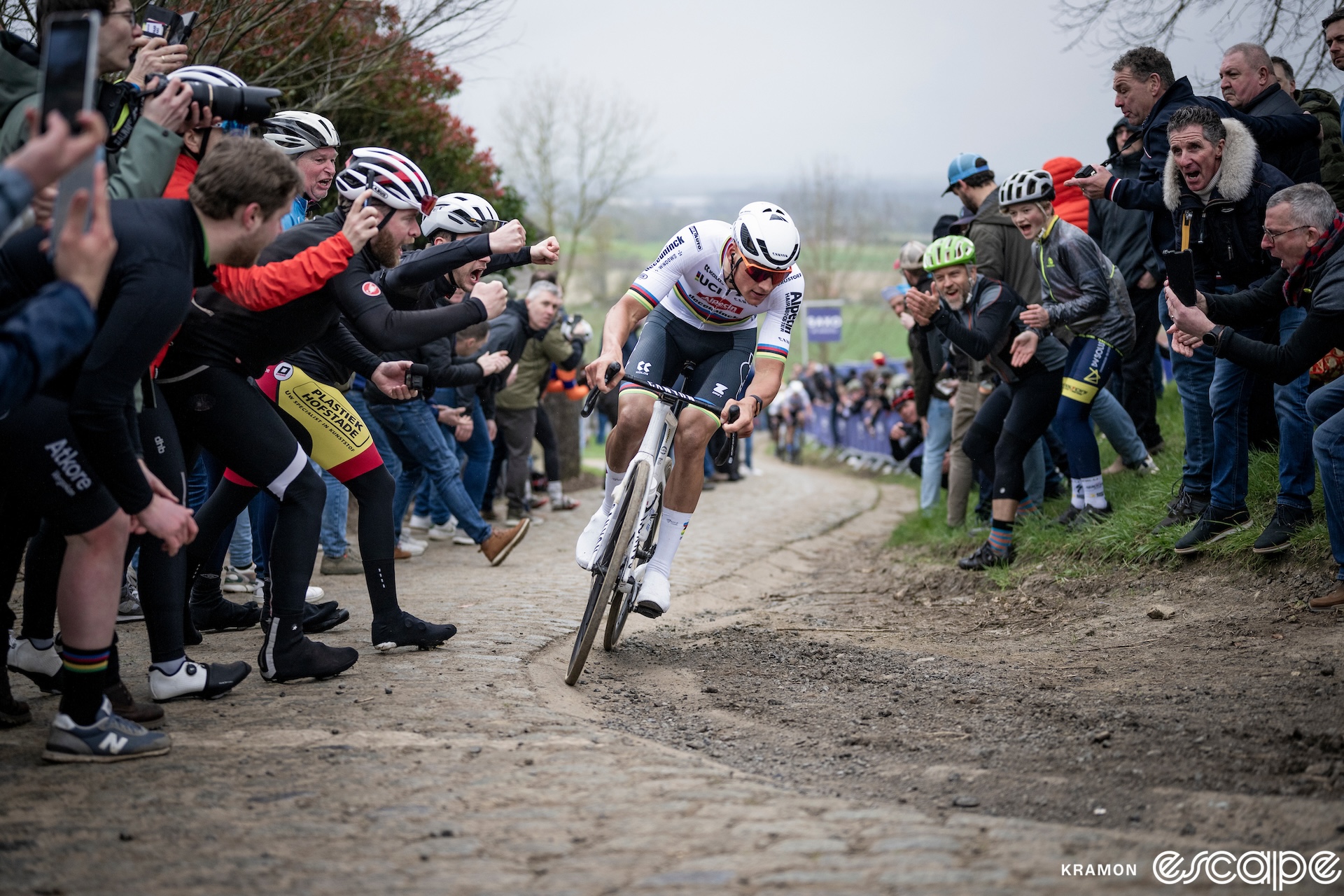
“If you understand the nuance of cycling it kind of makes you one of the cool kids; you’re part of this little exclusive club that knows how the sport really works,” said Vaughters. “But cycling is very exclusive to the broader public. It all makes sense to us because we’ve kind of grown up with it, but to a new fan, it’s, ‘Wait a minute: the world champion isn’t even the best rider in the world?’”
And while the racing has gotten faster and more dynamic, many of its fundamentals haven’t evolved in decades or longer, even as other sports have. Major Classics and Grand Tour stages, which are increasingly shown live start to finish, can last four to six hours. That’s a massive investment of fans’ leisure time compared to the crisp 90 minutes plus stoppage time of a football match or the two hours for an average NBA game (including halftime) or F1 race.
So just tune in for the exciting bits? Sure; when are those? For long stretches of a race the action can seem stagnant: aside from crashes, descents, and attacks, before the 10 km to go banner racing very often looks like a pack of largely faceless and indistinguishable riders moving across the landscape without much obvious physical effort or athletic skill, or a breakaway that dangles interminably for hours in front of the TV cameras.
Then in an instant, chaos can strike as at Dwars or Itzulia or the recent Critérium du Dauphiné; or Pogačar or Van der Poel make a long-range attack and the final hour of racing is a fait accompli rather than a crescendoing finale of anticipation. There’s no easy format for predicting when the action will happen in a given race, so fans either have to commit to the full broadcast or risk missing crucial moments. Factors that keep hardcore fans engaged, like the chess match of team tactics – who works when and whether it will pan out – are inscrutable to many others.
Speaking of broadcasts: live coverage – which fans increasingly have to work to find, and which is often only accessible with paid streaming memberships – has also largely failed to evolve the past two decades even as other sports have shot past it in terms of sophisticated production. Commentary can be wildly uneven and there’s little in the way of on-screen info to help newer fans understand tactics or crucial moments; the graphics that do exist, such as current power or speed readouts, often simply confuse matters more.
In some ways, pro road racing makes most sense as an anachronism. It was created over a century ago as the raw material for mythic narratives to sell newspapers: material that could be massaged to create those gripping story arcs and smooth over the hours of less-eventful racing that, today, commentators now must fill live with all manner of ad-libbed digressions that – while an admirable talent – sometimes come at the expense of explaining what’s happening on screen.
As a result, the variety and nuance of the sport which the dedicated fan finds fascinating is opaque and inaccessible to a casual viewer. A recipe for explosive growth it is not. Perhaps it’s possible to change that. But one major entity stands in the way of change, which illustrates the second major difference between cycling and other sports.
‘A crazy way to run a sport’
Perhaps because of how it grew organically over decades, and because road racing has never been consolidated in the way that F1 has or become a socialist collective in the way that the NFL is, the sport has an unwieldy, unbalanced power structure. Most sports have some division of power between groups like athletes, teams, events, and a league or governing body. But in almost every other case, two or more of those entities are combined (in the NFL, for instance, teams are the league, and the league controls both the games and – through the teams – the stadium venues, so the power structure is bi-polar, if not co-equal, between league/teams and players). In cycling, those four groups are all distinct.
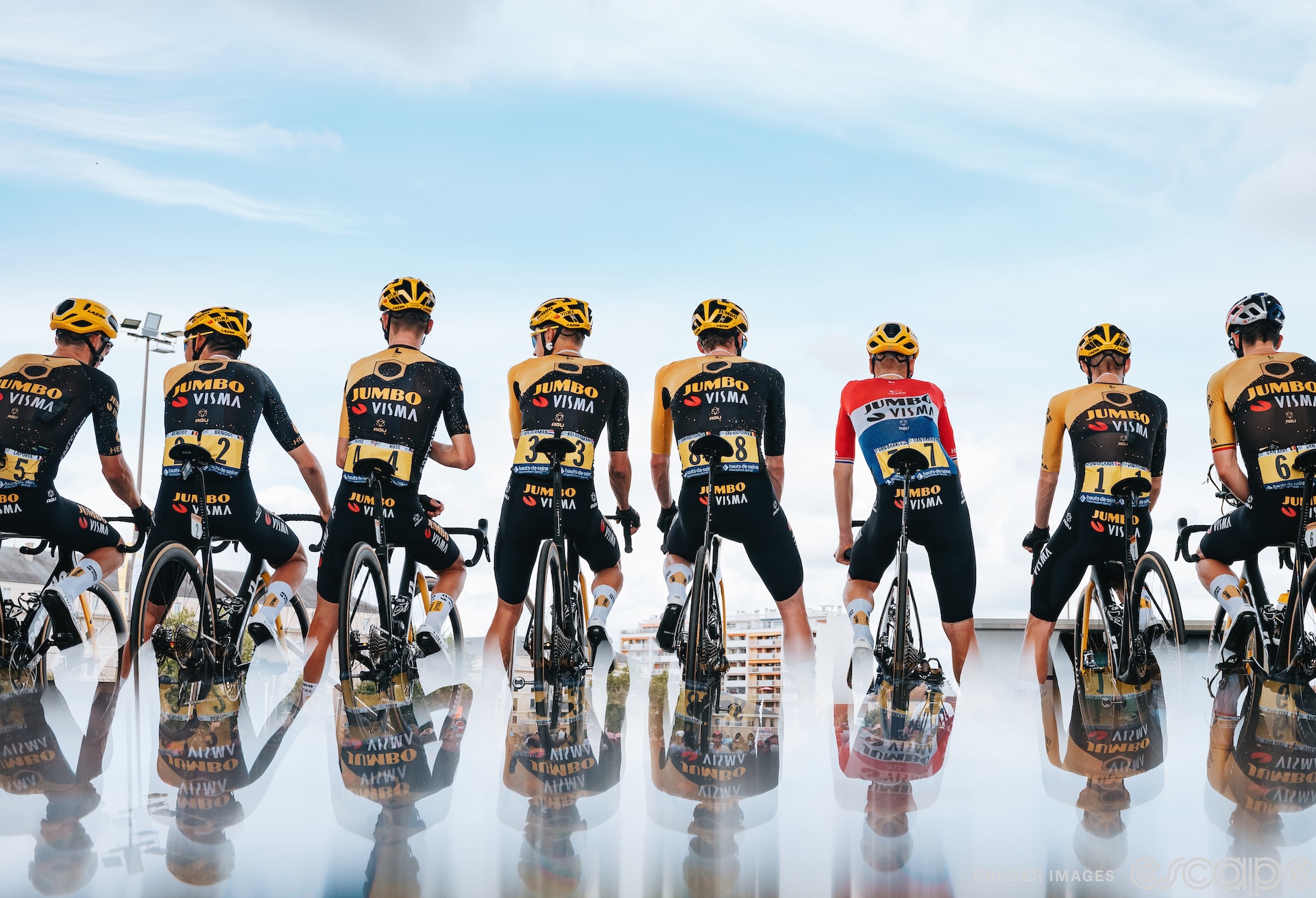
Lowest and least in stature are the riders. The men’s peloton has a nominal union, the CPA, which, under new president Adam Hansen, is finally showing signs of joining phylum Chordata. But historically, riders have had vanishingly little real power in the sport.
For revenue, riders are mostly dependent on paychecks from their teams (prize money from races is typically split among riders and staff). While star riders earn millions of Euros a year, and even top domestiques can draw mid-six figure paychecks, the falloff is steep, and while the WorldTour minimum wage is rising, at the bottom in 2025 it will still be just €44,150 for men (€72,404 for riders employed as contractors) and less for women: €38,000. Earnings from personal endorsement deals or appearance fees vary just as widely. And athletes’ time in the sport – their earning window – is short. Even for male cyclists ranked in the top 150 riders in the world, the average professional career lasts just under a decade [Figure 5], and not all of that time is necessarily spent at the WorldTour level.
The next group, one rung up the ladder: teams. The total, sport-wide budget of the WorldTour peloton is significant: estimated at around €450 million annually across the 18 teams, although that masks a wide range from top to bottom. Most team budgets are not public, but it’s generally thought that €28 million represents an average. The best-funded teams reportedly have budgets in excess of €40 million, almost three times higher than the smallest WorldTour teams. But we can’t call that bucket of money revenue, exactly. Team budgets come almost overwhelmingly from corporate sponsorships.
Those sponsorship deals are essentially a marketing expenditure for the supporting companies, which in most cases do not own the teams (EF Education, Trek, and Ineos Grenadiers are prominent exceptions). Teams don’t share in media rights and because road racing doesn’t take place in controlled venues, there’s no ticket revenue. The only true revenue most teams earn, from VIP events or merchandise, is largely a rounding error.
Teams also have no major assets of note. Their intellectual property is minimal; you know Ineos Grenadiers, not Tour Racing Limited; Alpecin-Deceuninck, not Wielerteam Ciclismo Mundial. Office and service course spaces are often leased, not owned, and physical assets like the massive team coaches depreciate quickly. Even the WorldTour licenses teams hold have almost no market value and can be stripped entirely – without compensation – in the churn of the relegation cycle.
“What is a WorldTour license worth? I’m the perfect person to ask, because I bought one,” Adams told Andy McGrath (Israel-Premier Tech purchased Katusha’s license after 2019). “It’s not worth much. It’s a liability; it forces you to spend money to keep the enterprise afloat.” Without deep-pocketed owners like Adams or Ineos’ Jim Ratcliffe to backfill the inevitable shortfalls, teams are at constant risk of simply going out of business.
Finally, teams create zero return on investment for their owners, and that is literally by design: buried in the UCI rules on road racing is a clause (2.15.090) that essentially requires teams to run as non-profits. “I’ve spoken to owners of other teams who live under tremendous stress from year to year, and some of whom have told me, ‘We’d be better off selling our team,’” and simply working as salaried managers, said Adams. “It’s a crazy way to run a sport.”
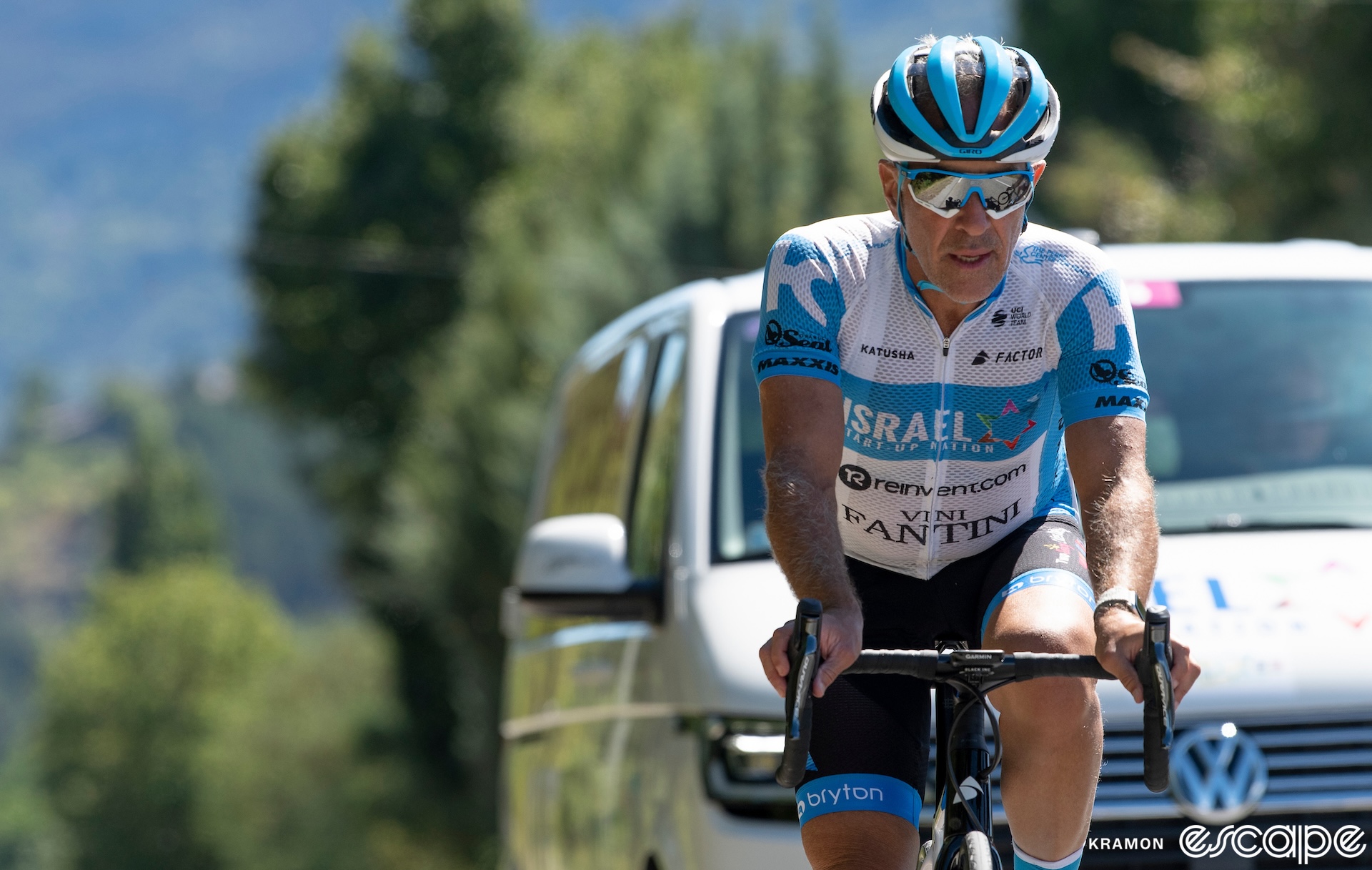
Speaking of the UCI, the sport’s third stakeholder occupies a unique spot thanks to its International Olympic Committee-recognized role as the official governing body of bike racing worldwide, which grants it a monopoly of sorts.
Again, thanks largely to its transformation under former president Verbruggen, the UCI is now a well-staffed professional organization. While a decent chunk of its CHF 40 million annual budget comes from sanctioning race promoters’ events and awarding team licenses, more than two thirds of its revenue derives from the events that the UCI itself owns and runs – or, namely, the hosting fees and commercial and media rights attached to those events, led by its flagship property, the Road World Championships. That puts it somewhat in the race promoter category. But even the UCI, with its IOC-bestowed monopoly and quasi-promoter status, isn’t truly a member of the most powerful class of stakeholders in pro cycling.
At the very top sit the companies that own and run the races on the men’s and women’s WorldTour circuits. Race organizers have – theoretically – the broadest revenue base. They can earn money from host towns that bid on the right to hold starts and finishes, from selling corporate sponsorships and merchandise, from VIP viewing areas and participation events like sportives, and of course from those all-important media rights. But race organizers are not all on that top step together; for some events those revenue streams actually reverse and become cost centers (paying for TV time, for instance). There’s a clear hierarchy of power among the promoters, which has directly to do with how lucrative each of those revenue streams is. And that, in turn, has to do with the number and stature of the races they each organize.
Of the 35 events in the men’s WorldTour, more than half are run by just three companies: Flanders Classics, RCS Sport, and the ASO. Of those three, the ASO stands clearly at the top, thanks largely to the Tour de France.
One statistic more than any other illustrates the ASO’s power. To pitch or retain sponsorships, pro teams assemble marketing decks that attempt to quantify the media exposure they’ve delivered over past seasons. In those decks, the Tour de France alone invariably accounts for around 75% of any team’s total annual media exposure value. The Giro d’Italia plays big in Italy. The Vuelta a España is certainly important for brands like Movistar that target the domestic Spanish telecom market. But numbers tail off outside the home nation; worldwide, nothing moves the needle like the Tour.
So for any reform to truly work in the sport, sooner or later the ASO has to be involved. “That’s got to be done in a respectful way,” said Copeland of reform efforts. “If you’re going to do it behind the backs of ASO, you’re starting off on the wrong foot.” Adams’ assessment was a bit more pessimistic: “I don’t know if you can have a league when the Tour is such a dominant force in the sport,” he told McGrath.
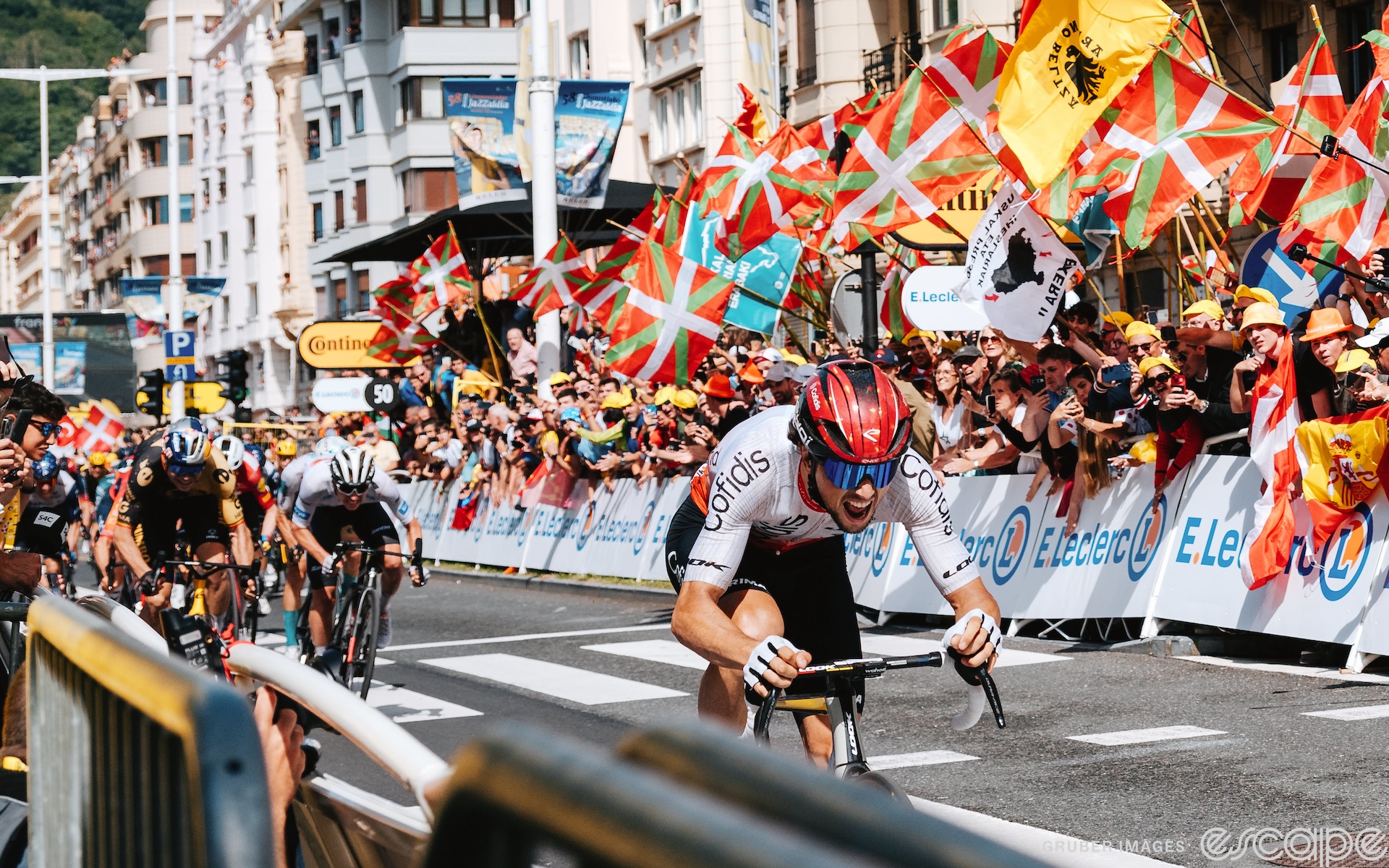
The key divider between the haves and have nots in pro cycling isn’t necessarily money. Even established, long-running WorldTour races can struggle to find revenue streams that are reliable enough to guarantee more than a year-to-year existence. As for teams, Jumbo-Visma dominated men’s stage racing last year and is admired as one of the best-funded and best-run outfits in the sport. But the decision by its lead sponsor (amid its own serious issues) to end its support created a near-existential crisis that forced the team to consider an ill-fitting merger with Soudal-Quick Step.
When that merger failed, the crisis didn’t abate until the team’s other co-title sponsor, Visma, and bike sponsor Cervelo (through parent company PON) stepped up to guarantee its budget. In a callback to the fate of HTC-High Road, for the second time in a little over a decade the sport’s best team was in danger of going from the pinnacle of pro cycling to out of existence in a matter of months. As Vaughters likes to say, that’s like the Tom Brady-era New England Patriots folding because they couldn’t find a sponsor. “Would never happen,” he added; the NFL’s business model wouldn’t allow it. What separates those in the sport of cycling with power and those without isn’t an amount of money per se. It’s stability: knowing that the cash will keep flowing year after year.
The ASO’s dominant role in the sport, thanks to its place controlling by far the most valuable and reliable property in cycling, effectively gives it a unilateral veto over anything that happens in pro road racing. No single other entity in the sport has that kind of power, and the result of its outsized piece of the cycling pie is that most other entities in the sport are locked in a kind of short-term, paycheck-to-paycheck thinking that prioritizes survival.
The result? Teams forced to consider hastily arranged mergers just to keep the doors open. Race organizers leaving in a descent known to be dangerous, or unwilling or unable to afford padding to line a stone culvert and protect riders from potentially life-threatening injuries. No single entity can shift the balance of power away from the ASO’s overwhelming control. But could they do it together?
Can cycling ever be a big-time sport?
We may begin to find out sooner than later. “The UCI has already said 2026,” said Visma’s Plugge when asked about the broad reform timeline, without mentioning One Cycling specifically. “The UCI wants to reform the calendar in a better way and also look into how we can work together to make sure cycling sports still exist in 10 years’ time, and even better than today.”
“2026 is a long shot, but possibly,” said Copeland of that goal. His immediate focus as new AIGCP head (replacing Plugge), he said, is simply to try to get all the teams aligned on goals, do an organizational audit, and bring in an outside president, someone “who doesn’t have any conflict of interest” like he or any other team official does. For more substantive reform to happen, things would have to move fast. The 2024 season is now half over, and, added Copeland, “by the time 2025 starts you’re already thinking about 2026. It’s pushing it.”
But even if reform starts to happen, there’s no guarantee that it will be in the form of One Cycling. And there is certainly no guarantee of success for such a sweeping project. Among the unknowns: what is the critical mass of teams and event organizers that must be involved to be a large-enough force to change the sport? Not everyone even agrees on where to start with that. Where Copeland wants to get the teams aligned philosophically as a step to approaching larger reforms as a group, his colleague Patrick Lefevere favors a lighter entourage in any negotiations. “With a small group, I think things move better,” the longtime Soudal-Quick Step manager told Escape in April in answer to a question about reform efforts. “We cannot be there with 18 teams and organizations and people who want to invest and whatever.”
Another unknown: If One Cycling pursues a similar “don’t poke the ASO bear” strategy that Velon did with Hammer, avoiding schedule conflicts and rendering unto the ASO Caesars what is theirs, will that be enough for the ASO to stay its powerful hand from any outright opposition?
And finally, is €250 million enough to actually get the project off the ground?
On one hand, that sounds like an absurd question. But €250 million isn’t as much money as it seems; it would cover only around seven months of operations for the entire WorldTour peloton, for instance – funds those teams would need if a 2008-style civil war with the ASO came to pass. (That massive war chest warrants noting again that, to this point, women’s racing has been completely absent from the discussions around One Cycling, even as investment in a younger sport with fewer entrenched interests would go further, with potentially an even more significant upside.)
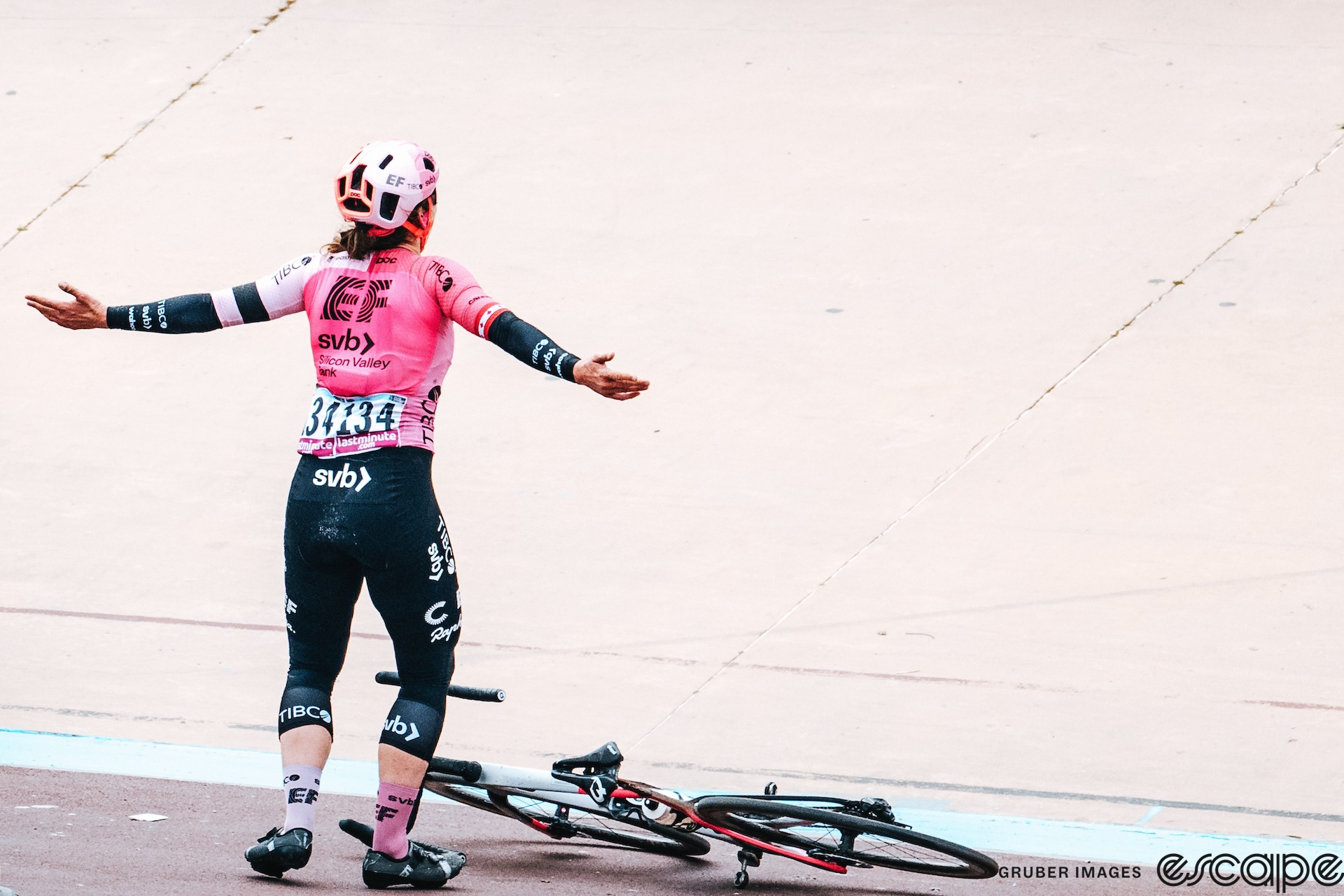
Finally, while €250 million is a large number by any objective measure, it pales compared to some other recent Saudi sports investments. Golfer Phil Mickelson’s signing bonus for defecting from the PGA Tour to LIV Golf was reportedly US$200 million. That’s for one player; the PIF’s total investment reportedly surpasses US$2 billion. But that highlights an appropriate point of comparison: for all of LIV Golf’s challenges, golf is a much larger media market than pro cycling.
A common perspective on the Saudi strategy for its sports spending is to view it through the lens of sportswashing. And the kingdom, beset with the kind of PR headwinds that naturally result when, say, senior officials greenlight luring a journalist critical of the regime under false pretenses and having him brutally killed and dismembered – on another nation’s soil, no less – would like to rehabilitate its image, for sure.
But Crown Prince Mohammed bin Salman faces a far larger challenge domestically. Saudi Arabia’s population skews exceptionally young; some 63% of the country’s 32 million citizens are under the age of 30. Employment for the prime 25-54 age group hovers under 70%, a solid 10 points below the OECD average. For decades, the Saudi government has showered its citizens with generous social benefits funded by the country’s immense oil wealth, as exemplified in the $7 trillion-with-a-T market capitalization of state-owned oil giant Saudi Aramco. But that largesse will not last forever.
The Kingdom has the second-largest proven oil reserves in the world, but its last major new discovery is more than 30 years old (it has had more recent gas discoveries). And there is significant debate about the remaining productive lifespan of key fields like Ghawar and Shaybah, even as only the Saudis know for sure what’s left in the ground. In its 2023 Energy Outlook, the International Energy Agency predicts fossil fuel use will peak in 2030. Oil prices have stayed persistently high, thanks to both sustained demand and disciplined production control from the OPEC+ cartel. But the Kingdom, like oil majors worldwide, is hemmed in by dwindling new reserve discoveries and the rise of renewables.
Under Bin Salman, Saudi Arabia has begun tentative social modernization. But it is still a repressive authoritarian monarchy (with a score of just 8/100 in the latest Freedom House rankings), and to keep its young population from becoming politically restive, a healthy economy is key.
So it’s entirely possible – more than likely, in fact – that the Kingdom isn’t plowing the Public Investment Fund’s nearly $800 billion cash trove into initiatives like LIV Golf or One Cycling to burnish its image. As with its huge tourism push, sports are an investment: the Saudis’ attempt – as outlined in their Vision 2030 project – to diversify their wealth and economy before the oil-powered money gusher starts to flag. And the thing about investments is you want a positive return on them.
That, as you’ll recall, is one of the sources of discontent in the sport over the One Cycling pitch: unrealistic ROI projections and – according to some sources and disputed by others – an investment structured as a loan where it’s the teams and principals in the sport who assume the risk rather than the paymasters.
If that ROI doesn’t come – if One Cycling can’t achieve a critical mass to force sport-wide reform; if ASO’s resistance can’t be overcome or at least sidestepped; if the media rights don’t end up being as valuable as hoped – it’s a bust, and the only question is who’s left with the bill. As former UCI president Brian Cookson noted on Twitter last October, without the right partners, there may not be much income at all. “…where is their ROI (Return On Investment) coming from, given that the profitable events won’t share and the other events have nothing to share?” he asked.

One Cycling’s pitch to the Public Investment Fund and to those within the sport is predicated on the idea that pro road racing is an undervalued backwater that, if properly managed and funded, can transform into a big-time, globally popular sport. “Nobody thinks cycling is that big of a sport, because the half a billion dollars teams spend every year is not in a league; it’s fragmented entities that are trying to murder each other,” said Vaughters, rather than a model like the NFL: competitive on the field but ultimately an integrated business. Vaughters believes pro road racing is undervalued, but can only achieve its potential by aggregating the interests of its disparate players.
Whether pro cycling has that major upside is unknowable right now, but issues in other sports with similar struggles suggest cause for skepticism. Again, no major sport has the structure that pro road racing does. But CVC Capital, the investment firm that SRJ supposedly beat out for One Cycling, has invested some £700 million in rugby over the past five years with a similar consolidate-and-reform plan, but the sport’s top division in England, the Premiership, is actually shrinking despite CVC’s £230 million stake in it, with three teams entering administration since September 2022. As a recent FT feature on rugby’s struggles noted, a key problem is that the sport’s media rights haven’t grown the way investors expected.
Tennis is caught in what may be an existential struggle over the future of the sport: last spring, multiple reports claimed the PIF launched a US$2 billion takeover bid for both the ATP (men’s) and WTA (women’s) tours. And in auto racing, teams in America’s NASCAR league are agitating over a similar dynamic to pro cycling, where they’re forced to survive on sponsor funding and are largely locked out of TV revenues, which they have so far been unable to convince NASCAR to share. As a result, some teams are in existential danger.
None of those situations suggests that pro cycling has an easy path to transformation. In fact, if the premise promoted by One Cycling’s backers is not true, then maybe pro road racing is actually too big. Given that four of the 18 WorldTour teams are sponsored by sovereign wealth rather than conventional corporate sponsors and two others are owned by billionaires, maybe the arms race started over a decade ago by Team Sky is an unsustainable bubble that will pop, bringing about a shrinkage in both the number of WorldTour teams and their budgets, resulting in a smaller sport with more scarcity.
That’s a sobering possibility. But just as sobering in other ways is the prospect of One Cycling’s promise coming true. The utopian ideal of such a sport is tantalizing: a coherent calendar with compelling, understandable, season-long narratives; a unified media rights landscape that offers simple, relatively easy-to-access coverage to fans (although if the NFL’s multi-platform strategy is any guide that may be a mirage); and stable and growing revenue streams for teams and event organizers that allow them to invest in their talent and operations and gain enough stability that there’s no longer a question of whether they’ll even exist year to year, and where putting safety netting on that tricky downhill corner with the dangerous runout zone isn’t an unaffordable luxury replaced by crossed fingers and hope.
But all of that is speculative, and if sports like F1 that have gone through seismic transformations are any guide, the real end result may look like something else entirely. If One Cycling’s backers are right, and a bet to reform the sport somehow does transform it into a global phenomenon many times its current size, then the resolution of all those questions will give rise to a new one: is what they built better?
Did we do a good job with this story?
